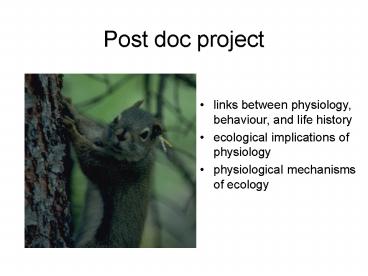Post doc project - PowerPoint PPT Presentation
Title:
Post doc project
Description:
timing of parturition important. natural (and experimentally induced?) variation in parturition date. predict early breeders have higher FMR (and RMR? ... – PowerPoint PPT presentation
Number of Views:100
Avg rating:3.0/5.0
Title: Post doc project
1
Post doc project
- links between physiology, behaviour, and life
history - ecological implications of physiology
- physiological mechanisms of ecology
2
(No Transcript)
3
Basic design
- natural and experimentally-induced variation in
autumn hoard size - winter behaviour and metabolism
- spring behaviour and metabolism
- reproductive success
4
a) Metabolic requirements of foraging in a cold
environment
- reduced hoard size increases cold exposure
- increases thermogenic requirements
- increased Summit MR FMR RMR in winter
5
b) Links between RMR, FMR, and SMR
- repeated winter and reproductive metabolic
measurements - quantified and experimentally manipulated food
availability
6
d) Metabolic consequences of early reproduction
- timing of parturition important
- natural (and experimentally induced?) variation
in parturition date - predict early breeders have higher FMR (and
RMR?), lower production efficiency, but higher RS
7
(No Transcript)
8
I. Autumn Hoarding Behaviour
9
Autumn 2001 Hoarding Observations SU/KL Cone
Count 19.5
Average 1170
Number of Individuals
Estimated Number of Cones Hoarded
10
Autumn 2002 Hoarding Observations SU/KL Cone
Count 35.0
Average 5020
Number of Individuals
Estimated Number of Cones Hoarded
11
Autumn 2003 Hoarding Observations SU/KL Cone
Count 9
Average 5020
Number of Individuals
Estimated Number of Cones Hoarded
12
Hoarding Functional Response
Estimated Number of Cones Hoarded
Number of Cones per Tree
13
Within Year Variation by Age and Sex Class
Autumn 2002 Hoarding Observations SU/KL Cone
Count 35.0
Number of Individuals
Estimated Number of Cones Hoarded
14
Scatterhoarding vs. Larderhoarding
Proportion of Cones Hoarded to 1o Midden
15
Mushrooms/Truffles vs. Cones
Number of Individuals
Frequency of Mushroom/Truffle Hoarding (proportion
of total of hoarded items)
16
Midden Surface Cone Counts
2001
2002
17
Midden Surface Cone Counts
2001 2002 Combined r2 0.32, p lt 0.001
18
II. Winter Reproductive Energetics
19
Winter Resting Metabolic Rate (RMR)
n 36, r2 0.11, p 0.047
Winter Resting Metabolic Rate (kJ/day)
Body Mass (g)
20
Winter Resting Metabolic Rate (RMR)
Winter Resting Metabolic Rate (kJ/day)
Avg 140 kJ/day
21
Winter Resting Metabolic Rate (RMR)
22
Winter Field Metabolic Rate (FMR or DEE)
n 51, r2 0.190, p 0.001
Winter Daily Energy Expenditure (kJ/day)
Body Mass (g)
23
Winter Field Metabolic Rate (FMR or DEE)
Winter Daily Energy Expenditure (kJ/day)
Avg 200 kJ/day
24
Winter FMR vs. Winter RMR
n 28, r 0.012, p 0.95
Winter FMR (kJ/day)
Winter RMR (kJ/day)
25
Winter FMR vs. Winter RMR
Winter Daily Energy Expenditure (x RMR)
Avg 1.45xRMR
26
Winter FMR and Lactating FMR
Daily Energy Expenditure (kJ/day)
27
Lactating FMR
n 46, r 0.001, p 0.94
Lactating Daily Energy Expenditure (kJ/day)
Body Mass (g)
28
Lactating FMR
Lactating Daily Energy Expenditure (kJ/day)
29
Lactating FMR
Lactating Daily Energy Expenditure (kJ/day)
30
FMR Summary
Daily Energy Expenditure (kJ/day)
LL Food Add
KL/SU Control
LL Control
31
Daily Energy Expenditure (kJ/day)
LL Food Add
KL/SU Control
LL Control
32
FMR Summary
1994 Control (following mast year)
Daily Energy Expenditure (kJ/day)
LL Food Add
KL/SU Control
LL Control































